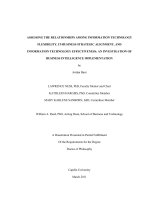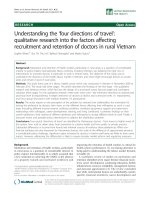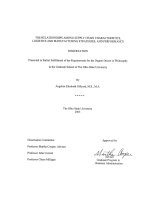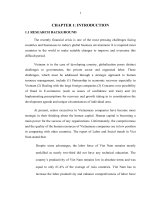The relationships among emotional intelligence, leadership styles and perfprmance of employees in enterprise in hanoi, vietnam
Bạn đang xem bản rút gọn của tài liệu. Xem và tải ngay bản đầy đủ của tài liệu tại đây (169.8 KB, 15 trang )
SUMMATION THESIS BY NGUYEN THI THU HUONG
PREFACE
In this summary dissertation, all figures and tables are numbered as in dissertation
Emotional Intelligence plays an important role in helping the managers and
employees to cope with this dynamic change in the business environment.
Leaders who possess emotional intelligence can easier guide own behaviours
and thinking processes to achieve results. Emotional intelligence is crucial especially for
leaders; it helps the leaders to motivate the team and achieve company’s objectives through
superior performance of the team. Vietnam enterprises need to find out how it works more
efficiently, one of the ways it is adopt leadership approaches that facilitate performance to
improve the efficiency of human resources.
Thus, the theme of " The relationships among Emotional Intelligence, Leadership
Styles, and perfprmance of Employees in Enterprises in Hanoi, Vietnam” is chosen to
study.
The structure of dissertation includes 5 chapters.
CHAPTER I: INTRODUCTION
1.1. BACKGROUND OF STUDY
Vietnam’s Renovation Policy (doi moi), which effectively started in 1987, has
encouraged investments both from inside and outside Vietnam. It has significantly boosted
the country’s economy and the living standard of the Vietnamese. Opening up the market
brought both threats and opportunities. Some businesses thrived in the new business
environment and were able to improve productivity, product quality, and ultimately profit.
Others failed to meet the new challenges and declined (Quang & Vuong, 2002). Human
Resources are playing a vital role in almost all aspects of life and in organizational
development. As more and more organizations are making progress, by making the use of
human resources, they need some means to increase the performance in human resource
by increasing the efficiency of leaders and their followersIn the Vietnamese complex
situation, a organization both public and private sector have to change their leadership style
in an effective way. research on leadership style has found that Emotional Intelligence is
1
playing the vital role in the performance of the leaders and the efficiency of
leadership skills.
1.2. STATEMENT OF THE PROBLEM
This study attempts to examine the relationship between leadership, emotional
intelligence and employees by dealing with the following issue:
1. Is there any relationship between leadership styles and employee performance?
2. Is there any relationship between employee performance and leaders’ emotional
intelligence?
3. Is there any relationship among emotional intelligence, leadership styles and
employee performance?
4. Which is the most effective leadership style in Vietnamese companies?
1.3. SIGNIFICANCE OF THE STUDY
There has been no known research regarding the relative effectiveness of
an emotionally
intelligent
transactional
leader and
an
emotionally
transformational
leader with respect to employee performance
intelligent
in a Viet nam
organisation. This study therefore aims to investigate and explore the relationship between
employee performance,
leadership
and emotional
intelligence
in a Viet nam
organisations.
1.4. SCOPE AND LIMITATION OF THE STUDY
As in any research, financial constraint posed a limitation. Instruments are
costly to purchase, and this initially posed a problem in finding instruments suitable for
this research. This study used instruments t h a t available to the researcher free of charge.
The sample composition in this research chosed in ha noi, where the of the
government and a large number of enterprises are located. The data generated by this
research, therefore, is limited to the geography.
CHAPTER II: REVIEW OF RELATED LITERATURE AND STUDIES
2.1. REVIEW OF RELATED STUDIES
This section present of 15 literatures related to the topic.
2.2. THEORETICAL FRAMEWORK
This section present the theoretical about three fators: Employee performance,
Emotional intelligence and leadership styles.
2
2.3. CONCEPTUAL FRAMEWORK
From the review of the related literature and studies, the Researcher designed the
conceptual framework illustrated below:
The Conceptual Framework
Emotional Intelligence
of Leader
H1
INI
I Leadership Style
H3
H2
Level of
Employees’
Performance
H1
H1:
There is a relationship between leadership styles and employees’
performance
H2:
There is a relationship between employee performance and emotional
intelligence
H3:
There is a relationship among emotional intelligence, leadership styles and
employees’ performance.
CHAPTER III: METHODOLOGY
3.1. Research design
The steps below is a representation of the research design employed for the
purposes of this study.
Step 1: Administer Questionares to both the leader and subordinate in the enterprises in Ha
noi.
Step 2: Capture the data and inspect the data using descriptive statistics and frequency
tables.
Step 3: Test for reliability of data (Cronbach’s alpha reliability coefficient)
Step 4: Test the research hypotheses using correlation, Anova, linear regression analysis.
Step 5: Analyse and discuss the results.
3
3.2. Population and Sample
The sample consisted of a nonrandom convenience (availability) sample of 375
leaders and 730 subordinates, making the total sample equal to 1105 participants.
3.3. Measuring Instruments Used
The scale for leadership style in the questionnaire:
The
scale
was
modified
from
the
multifactor
leadership questionnaire
called the MLQ (Bass and Avolio, 1997) and 28 questions for use in the study. After
factor analysis, 4 factors were extracted as the charismatic leadership, the transactional
leadership, the transformational leadership, the visionary leadership.
The scale for Emotional intelligence in the questionnaire
Following extensive research on the topic of Emotional Intelligence, an appropriate
instrument was identified, called the ECP . The questionnaire contains 46 statements
that measure levels of current emotional intelligence competence.
The scale for employee performance in the questionnaire
The scale adopts the design method of positive questions, through 7 evaluation
factors: quality, productivity, job knowledge, reliability, initiative, teamwork, customer
service. After factor analysis, 1 factors were extracted as employee performance.
3.5. Data gathering procedure
The instruments, consisting of a leadership questionnaire (leader version) and an
emotional intelligence questionnaire, accompanied by a covering letter were mailed
to those identified as leaders. The leader respondents were requested to complete
the
leader version. The leader respondents were also asked to complete the ECP
on a scale of 1 to 7 . In both measuring instruments, the respondents were informed
that they were allowed to leave a question/answer blank if the question appeared
unclear or ambiguous.
Similarly, a leadership questionnaire (subordinate version) and an emotional
intelligence questionnaire, accompanied by a covering letter were mailed to those
identified as subordinates of the leaders.
4
3.6. Statistical Analysis
The data was presented in a manner that allowed for easy analysis and testing, using
SPSS.
CHAPTER IV: RESULTS AND DISCIUSSIONS
4.1.
The Survey Respondents
There were a total of 1,105 survey respondents among leaders and subordinates
from the various business and offices in Vietnam.
As to gender, the next table shows that, overall, the male respondents outnumbered
the female counterpart by some 14%.
4.2. Relationship Between Leadership Styles and Employee
Performance
Leadership Styles.
The scores for each leadership style based on the responses of 375 leaderrespondents was calculated by the average of 3 questions, one for the leader and two for
his/her subordinates. The sample sizes, mean scores and standard deviations of each of the
leadership styles factors are shown in the next table.
Table 4.3: Mean Scores and Standard Deviations of Leadership Styles
Charismatic Leadership
Transactional Leadership
Transformational Leadership
Visionary Leadership
Valid N (listwise)
N
375
375
375
375
375
Minimum
3.28
3.05
3.29
3.11
Maximum
5.22
5.28
5.57
5.61
Mean
4.3085
4.1877
4.2718
4.2663
Std.
Deviation
.65434
.83704
.68488
.79225
Employees’ Performance: The scores for employee’s performance based on the
responses of 375 leader-respondents was calculated by the average of 3 questionaires, one
for the leader (as a member in organization, answer questionnaire for performance of own
his/her work) and two for his/her subordinates answer questionnaire for performance of
them.
Table: 4.4: Mean Scores and Standard Deviations of Employee Performance
5
N
Minimum
Maximum
Mean
Std.
Deviation
Quality
375
2.42
3.83
3.0944
.45687
Productivity
375
2.50
3.67
3.2138
.39681
Job knowledge
375
2.36
4.00
3.2429
.53340
Reliability
375
2.86
3.64
3.2737
.31402
Initiative
375
2.50
4.08
3.2367
.57484
Teamwork
375
2.20
3.50
3.0275
.44819
Customer Service
375
3.00
4.00
3.3743
.36621
Employee performance
375
2.64
3.77
3.2090
.40198
Valid N (listwise)
375
Hypothesis One:
H01
There
is
no
significant
relationship between leadership styles and
employee performance
H11
There
is
significant
relationship between leadership styles and
employee performance
The summary of the linear regression model for this hypothesis shows a high
adjusted R2 (Adjusted R² = 0 . 902) indicative of an over-all very high correlation
between the independent and the dependent variables. With 90.2% variation in
employee performance and F value to 859.761, and p = 0.000, the null hypothesis
(Ho1) is hereby rejected and concludes that there is sufficient evidence, at the 5% level
of significance, that there is a linear relationship between employee performance and
leadership styles. This means, the leadership styles have strong effect on employee
performance.
The significant parameters are the intercept (beta coefficient = 0.905, p =
0.001) and transactional leadership parameter (beta coefficient = 0.04, p = 0.001).
transformational leadership parameter (beta coefficient = 0.156, p = 0.000), charismatic
leadership parameter (beta coefficient = 0.303, p = 0.000). The visionary leadership
parameter is not significant (beta coefficient = 0.048,
p = 0.072) in this model.
This implies that visionary leadership is not having a significant effect on the employee
performance scores at the 5% level of significance, when considered in this model.
Results of hypothesis one testing showed that there is linear relationship between
leadership styles and performance of employees. The leaders use any leadership styles
also affecting the performance of their subordinates and the different styles will have
6
different effects. However, in this model indicates that relationship depends only on
transformational leadership, charismatic leadership and transactional leadership i.e. there
is no effect due to visionary leadership.
4.3. Relationship Between Employee Performance and Leaders’
Emotional Intelligence
Leaders’ Emotional Intelligence. The leaders’ emotional intelligence were
rated on a Likert’s scale ranging from 1 – 7 where 1 is equal to low EI, 4 is equal
medium EI and 7 is equal to high EI. The details of the statistical treatments are
provided for in Appendix L. The ECP factors which include the emotional
literacy,
self-esteem,
self-management,
self- motivation, change resilience,
interpersonal relations and integration of head and heart were combined (summed) to
generate the emotional intelligence scores.
Table 4.5: Mean Scores and Standard Deviations of Emotional Intelligence
Std.
N
Minimum
Maximum
Mean
Deviation
Emotional Literacy
375
3.56
5.67
4.5533
.69056
Self-Esteem/ Self –regard
375
3.39
5.33
4.4027
.62833
self- Management
375
2.61
5.44
4.0613
.82849
self- Motivation
375
3.61
5.06
4.1477
.45485
Change Resilience
375
3.71
4.95
4.2705
.45475
Interpersonal Relationships
375
3.67
5.89
4.5211
.82558
Integration of Head and heart
375
3.17
5.22
4.1881
.68575
Emotional intelligence
375
3.40
5.34
4.3064
.59559
Valid N (listwise)
375
For the dimensions of emotional intelligence, the mean Emotional Literacy
score was the highest out of the seven dimensions at 4.5533. This score, however, was
only slightly higher than the a medium EI.
The standard deviation of Change
Resilience was lowest (SD=0.45475) showing a low variation in the level of change
resilience amongst leaders. The mean score of EI was 4.3064 showing that the overall
emotional intelligence of the leaders was only a little higher than medium EI. As
detailed in Figure 4.1 below, there was a very low variation in the emotional
7
intelligence score. 75% leaders have scores of EI under 5 score indicating that most of
leaders in Vietnam companies have medium emotional intelligence scores. That mean
most of Vietnamese leaders need improve their emotional intelligence to reach higher
emotional intelligence. Emotions help leaders adapt to the physical and social world.
By combining social and emotional issues it has beome possible to develop way of
achieving a competitive advantage in the business environment.
Figure 4.1. Box Plot of Emotional Intelligence Scores.
Hypothesis Two:
H21
There is no relationship between employee performance and emotional
intelligence.
H22
There is relationship between employee performance and an emotional
intelligence.
Table 4.6: Correlations Between Emotional Intelligence and Employee Performance
Emotional Intelligence
Pearson Correlation
Emotional
Employee
Intelligence
Performance
1
.897**
Sig. (2-tailed)
Employee performance
.000
N
375
375
Pearson Correlation
.897**
1
Sig. (2-tailed)
.000
N
375
**. Correlation is significant at the 0.01 level (2-tailed).
8
375
The statistical tests as shown in table above clearly show that there was relatively
strong, significant, positive linear relationship between emotional intelligence and
employee performance (r = 0.897, p= 0.0001). Therefore, the null hypothesis (Ho2)
was being rejected.
T here was sufficient evidence, at the 5% level of
significance, that there was a positive linear relationship between emotional intelligence
and employee performance. Th e ab o v e resu lt s ho wed th at a lead er wit h high
emotional intelligence were increasingly more effective leaders and as performance of their
employees were also higher.
4.4. Relationships among Emotional Intelligence, Leadership
Styles and Employee Performance
In the previous sections, the respondents’ scores on emotional intelligence,
leadership styles and the employees’ performance were already discussed exhaustively.
This sections presents the discussions on the relationships of the three variables by
working on the third hypothesis.
Hypothesis Three
H03
There
is
no
significant
linear
relationship
among
emotional
intelligence, leadershi p st yles and employee performance.
H13
There
is
a
significant
positive
linear
relationship
among
emotional intelligence, l ead ers hip st yl es and employee performance.
The tests clearly showed that there was relatively high positive linear relationship
among emotional intelligence, leadership styles and employee performance (Adjusted R²
= 0.998). Therefore, the researcher rejected the null hypothesis (H03) and concluded
that there was sufficient evidence, at the 5% level of significance,
that t h e r e
e x i s t e d a positive linear relationship among emotional intelligence, leadership styles
and employee performance. Conversely, the regression analysis result showed that the
leadership styles and emotional intelligence of leaders affected the employee performance.
With the same leadership style, a leader with higher emotional intelligence can inspire his
subordinates and raise their performance level. However, when combined with emotional
9
intelligence the different leadership styles have different effects on the performance of
employees. While emotional intelligence - transactional leadership, emotional intelligence charismatic leadership and emotional intelligence - transformational leadership have a
significant positive effect on the employee performance as compared to
emotional
intelligence - visionary leadership which has negative effect on the employee performance
(beta coefficient = -0.413,
p = 0.000) implying that this leadership style was not
effective.
4.5.
Most Effective Leadership Style in Vietnamese Companies
The previous sections presented that emotional intelligence and leadership styles
have significant effects on the employee performance. This section discusses the most
effective leadership styles among leaders in Vietnamese companies.
The results of statistical tests implies that the relationship between the emotional
intelligence - charismatic leadership (beta coefficient = 0.410, p = 0.000) was stronger
than emotional intelligence - transformational leadership (beta coefficient = 0.134, p =
0.000), emotional intelligence - transactional leadership (beta coefficient = 0.226, p =
0.000) and emotional intelligence - visionary leadership (beta coefficient = -0.413, p =
0.000).
The t-test was used to determine if beta coefficient of charismatic leadership (ß 3 )
was biggest or not. A t-test rejects Ho in favor of H1 when t test z ( z - the upper
quantile of the standard normal distribution).
The summary of hypothesis testing result pointed out that all the null hypotheses
H0 must be rejected. It was clear that the beta coefficient of charismatic leadership(ß3 )
was greater than the beta coefficient of transactional leadership (ß2 ), greater than the beta
coefficient of visionary leadership (ß4 ), and greater than the beta coefficient of
transformational leadership (ß5).
10
Table 4.7: Summary of Hypothesis Testing Results
Hypothesis
t-test
( t test
z
Results
ˆ3 ˆi
)
se( ˆ3 ˆi )
H 0 : 3 2
H1 : 3 2
41.37726
1.649949
Reject the null hypothesis H0
H 0 : 3 4
H1 : 3 4
127.7264
1.649949
Reject the null hypothesis H0
H 0 : 3 5
H1 : 3 5
55.13461
1.649949
Reject the null hypothesis H0
These results implied that the charismatic leadership has the strongest effect on
employee performance out of four leadership styles. Therefore, the charismatic leadership
is the most effective leadership styles in Vietnamese companies. That is to say, a leader
with personal charisma can inspire his/her subordinates and raise their performance and
agglomerate group consensus to promote the business performance of the enterprise.
CHAPTER V
SUMMARY OF FINDINGS, CONCLUSION AND RECOMMENDATIONS
5.1. Summary of Findings
1. There exists a relationship between leadership styles and employee
performance. The results of the linear regression analysis indicate that, at the 5%
level of significance, there is a linear relationship between employee performance
and leadership styles. Furthermore, the results indicate
that a visionary leadership
has no significant effect on employee performance when considered in this model
(beta coefficient = -0.48, p = 0.072). In other words, leadership styles can either
motivate or discourage employee, which in return can cause employee’s increase or
decrease in their level of performance. However, only three leadership styles: the
transactional leadership, the transformational leadership and the charismatic leadership
was seen to have a positive effect on the significant subscales of employee
performance and a visionary leadership has no significant effect on employee
11
performance i.e. employee performance is not effected by the level high or low score
of the visionary leadership of the leaders.
2. There exists a positive relationship between employee performance and leaders’
emotional intelligence based on linear correlation analyses, at the 5% level
of
significance. That’s mean, it sugest effective leaders use their emotional intelligence to not
only manage themselves but to effectively manage their subordinates, the leaders with high
degrees of emotional intelligence will generate outcomes for their employee of company,
their employee have higher performance than leaders with lower levels of emotional
intelligence.
3. At 5% level of significance, there is a relatively high, positive linear relationship
among emotional intelligence, leadership styles and employee performance. This results
showed that a combination of the various leadership styles and emotional intelligence of the
leader will bring more effective and enhance employee performance. However, out of four
leadership styles, the visionary leadership combine leader’ emotional intelligence has
negative effect on employee i.e. with the same level of emotional intelligence, the leaders
show higher level of the score of the visionary leadership seem their employee have the
score of performance lower than others.
4. Although emotional intelligence and leadership styles had a significant effect on
employee performance, the emotional intelligence, charismatic leadership were affected
more than others. That’s mean subordinates will be inspired with more personal
charisma of the leaders, make more performance for company. The same emotional
intelligence, the leaders have a higher degree of the charismatic leadership cause their
employee have higher performance than the leaders have lower level of the charismatic
leadership.
5.2.
Conclusion
The broad objective of this research was to examine the relationship between
employee performance, leadership and emotional intelligence in a enterprise in Hanoi,
Vietnam. In terms of this research, employee performance,
leadership
styles and
emotional intelligence were discussed in terms of the research context. In an effort
to investigate the broad objective of the research, four specific research questions were
generated. The research question presented at the beginning of this dissertation questioned
whether there was empirical evidence to substantiate or support the surmised relationship
12
between leadership styles and employee performance, emotional intelligence and employee
performance, a combination of leadership styles and emotional intelligence effect on
employee performance.
In this study employee performance was identified as the dependent variable,
and leadership and emotional intelligence as the independent variables.
The general methodology consisted of the use of three instruments. The
Leadership styles questionnaires was used to collect information about leadership
styles of the leaders and the ECP was used to collect information about emotional
intelligence of the leaders. The third variable, Employee performance evaluation was
captured performance of both leaders and employees. The data was analysed using
linear regression analysis, simple correlation analysis and t-test.
The result of the first hypothesis showed, through linear regression analysis,
that there is a statistically significant relationship between employee performance and
leadership styles. The second hypothesis showed, through simple correlation analysis,
that there is positively correlated between employee performance and an emotionally
intelligent. The third hypothesis showed that there is a relative significant linear
relationship between emotional intelligence, leadership styles and employee
performance. The answer of final question was found through testing three
hypothesis indicated the emotional intelligence, charismatic leadership has a greater
impact on employee performance.
After a review of the literature on employee performance, leadership styles,
emotional intelligence of leaders in Vietnam, some reference to this research context
could be found. That is the empirical evidence to prove the role of emotional intelligence
of leaders in their work. And descriptive statistic and the result of testing show that the
charismatic leadership have the more important to employee performance. This is support
to the research Vietnam context in chapter 1, personal charisma like: titles, status, and
formality are very important in Vietnamese society.
This research therefore adds a new dimension to employee performance,
leadership and emotional intelligence, as this research takes place in a Vietnamese
companies context.
5.3.
Recommendations
5.3.1.Recommendations for the leaders
13
- The results of this study suggest that emotional intelligence does have a significant
effect on employee performance, indicating that emotional could help leaders improve their
leadership performance. Emotional intelligence can be taught and improved via training
and development activities within the workplace. The leaders or the persons who want to
become a leader should take part in these programs, it could help increase their emotional
intelligence and thus have a positive effect on their leadership performance. The ability to
manage one’s emotions and the emotions of others has been shown to be an important
indicator of success at work.
-
Many scholars and experts think that excessive division of labor and
specialization will make employees feel a drab and boring job. Thus, in order to improve
performance of
employees,
leaders should also tend to
the charismatic leadership
conforming to no conventional patterns and engaging in innovative and normative actions,
besides introducing a development and inspiring strategic incentive
system.
When
subordinates’ willingness and ability to work are low, they may show behavior deviation
from rules and standards or even high proportion below the standards.
5.3.2.Recommendations for the enterprises
- Enterprises should encourage and support training programs regarding aspects of
emotional
intelligent/
emotional
quotient,
charismatic
leadership
and
performance.Emotional intelligent can be improved upon with training and development.
Therefore, training programs within the enterprises could have a positive effect on
leadership and leadership performance, hence driving the enterprises to enterprises success.
- Enterprises would
to create an assessment tool that focus on an applicant’s
knowledge, skills and abilities to include a measure of emotional intelligence to increase
the probability of successful person job fit for the enterprises.
- Selection committees can use an emotional intelligence appraisal tool to help
identify candidates with high levels of emotional intelligence, candidates best able to use
their emotional intelligence to enhance their leadership performance within the enterprise
environment or try to assess a leaders’level of emotional intelligence during the interview
process.
5.3.3.Recommendations for future researchers
14
- Demographics must be explored further to ascertain the disparity of emotional
intelligence levels in men and women.
- This study only chose sample in enterprises in north of Vietnam, Future research
could examine larger samples of age groups and/or work teams. Geographical regions also
could be included
- Further research also should focus on emotional intelligence, leadership styles and
employee performace in specific fields, such as the service industry, retail, or financial
institutions to name a few.
15









